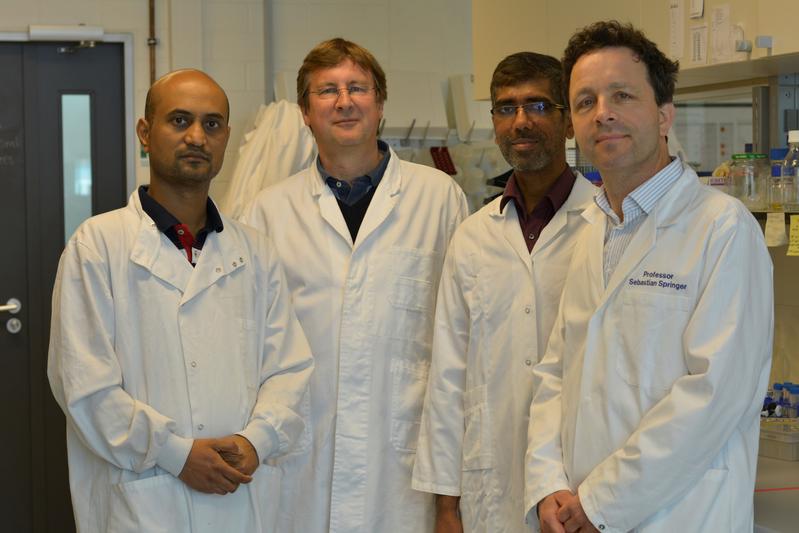

The working group of Sebastian Springer with Ankur Saikia, Raghavendra Anjanappa and Sebastian Springer (from left) plus Prof. Dr. Martin Zacharias (TU Munich, second from left).
Professor Sebastian Springer
Time and again, humanity has been troubled by virus epidemics. Viruses can invade body cells and multiply inside them, often killing the infected cells and causing diseases. The success of the immune response to viruses, just like the success of vaccination against them, depends on the action of a group of defense proteins called the MHC class I proteins.
They bind small fragments (called peptides) of virus proteins and hold on to them at the surface of the cell such that the T-killer cells of the immune system can test them, and possibly kill the virus-infected cells.
For many years, researchers have wondered how it is that the inside of the MHC class I proteins, the so-called peptide binding groove, fits so well to the peptides. Of course, an excellent fit is essential for making a stable complex, and so for scientists who would like to understand the nature of the immune response against viruses (and design new vaccines), it is important to know how this excellent fit comes about.
“The problem was”, explains Springer, “that no one knew what the empty binding groove looked like and what kind of changes occur upon peptide binding. So we felt we had to figure out the shape, or structure, of the empty peptide binding groove.”
That turned out to be much easier said than done. Without the peptide, the MHC class I proteins are flexible and unstable, sticking together and being very difficult to study. So, Springer – together with his colleague, the bioinformaticist Professor Martin Zacharias at the Technical University of Munich – decided to stabilize one particular MHC class I protein named HLA-A*02:01 with a chemical cross bridge called a disulfide bond.
“It was difficult”, says Springer, “to figure out where to put the disulfide bond. But with the help of computer simulations we finally found the right place and were able to synthesize a stabilized MHC class I protein in an empty form for the first time.”
Springer then turned to two colleagues, the structural biologists Dr. Rob Meijers and Dr. Maria Garcia-Alai at the Protein Crystallization Facility of the European Molecular Biology Laboratory in Hamburg, and asked their help in elucidating the structure by X-ray crystallography. After about two years of work, Meijers and his team were successful.
“We are so grateful to Rob because his results really opened our eyes and showed us at a glance what happens when the peptide binds”, Springer remembers the moment he saw the data for the first time.
“The peptide binding groove is a long narrow cleft. Now when the peptide binds, it touches a particular place in the binding groove called the F pocket causing a shape change of a large part of the entire groove. It's almost like watching a Venus flytrap catch a fly – the fly only touches one of the tiny hairs inside, and the entire leaf snaps shut.” Springer anticipates that the new understanding of this shape change will allow researchers to manipulate peptide binding and with it the immune reaction to viruses.
“Since MHC class I proteins come in many different kinds – about ten thousand different versions exist in the human population – there is a lot to do for us in the future.”
About Jacobs University Bremen:
Studying in an international community. Obtaining a qualification to work on responsible tasks in a digitized and globalized society. Learning, researching and teaching across academic disciplines and countries. Strengthening people and markets with innovative solutions and advanced training programs. This is what Jacobs University Bremen stands for. Established as a private, English-medium campus university in Germany in 2001, it is continuously achieving top results in national and international university rankings. Its more than 1,500 students come from more than 120 countries with around 80% having relocated to Germany for their studies. Jacobs University’s research projects are funded by the German Research Foundation or the EU Research and Innovation program as well as by globally leading companies.
For more information: www.jacobs-university.de
Jacobs University Bremen
Professor Sebastian Springer
Tel: +49 421 200-3243
Email: s.springer@jacobs-university.de
Link to the paper:
https://www.nature.com/articles/s41467-020-14862-4












